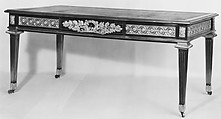Writing table (bureau plat)
Not on view
This bureau plat by Jean-François Leleu exemplifies the Neoclassical style favored by elite French patrons at the end of the eighteenth century. Jean-François Leleu (1729–1807) was trained, alongside his rival Jean-Henri Riesener, in the workshop of Jean-François Oeben. Leleu became a master ébéniste in 1764 and enjoyed the patronage of wealthy aristocrats, including the Prince de Condé, Louis-Joseph de Bourbon. Similar to the pieces produced for the prince de Condé’s Palais-Bourbon, this table reflects the strong, masculine Neoclassical forms favored by Leleu, evidenced by the tapering architectural legs and gilt-bronze ornaments. A similar writing table is rendered in the 1808 portrait of Charles Maurice Talleyrand by François Gérard also in the museum’s collection (2012.348).
References:
Yannick Chastang. Paintings in Wood: French Marquetry Furniture. London: The Wallace Collection, 2001.
Kahtyrn Calley Galitz, "François Gérard: Portraiture, Scandal and the Art of Power in Napoleonic France," The Metropolitan Musuem of Art Bulletin, LXXI: 1 (Summer 2013), 5–48.
Due to rights restrictions, this image cannot be enlarged, viewed at full screen, or downloaded.
This artwork is meant to be viewed from right to left. Scroll left to view more.



